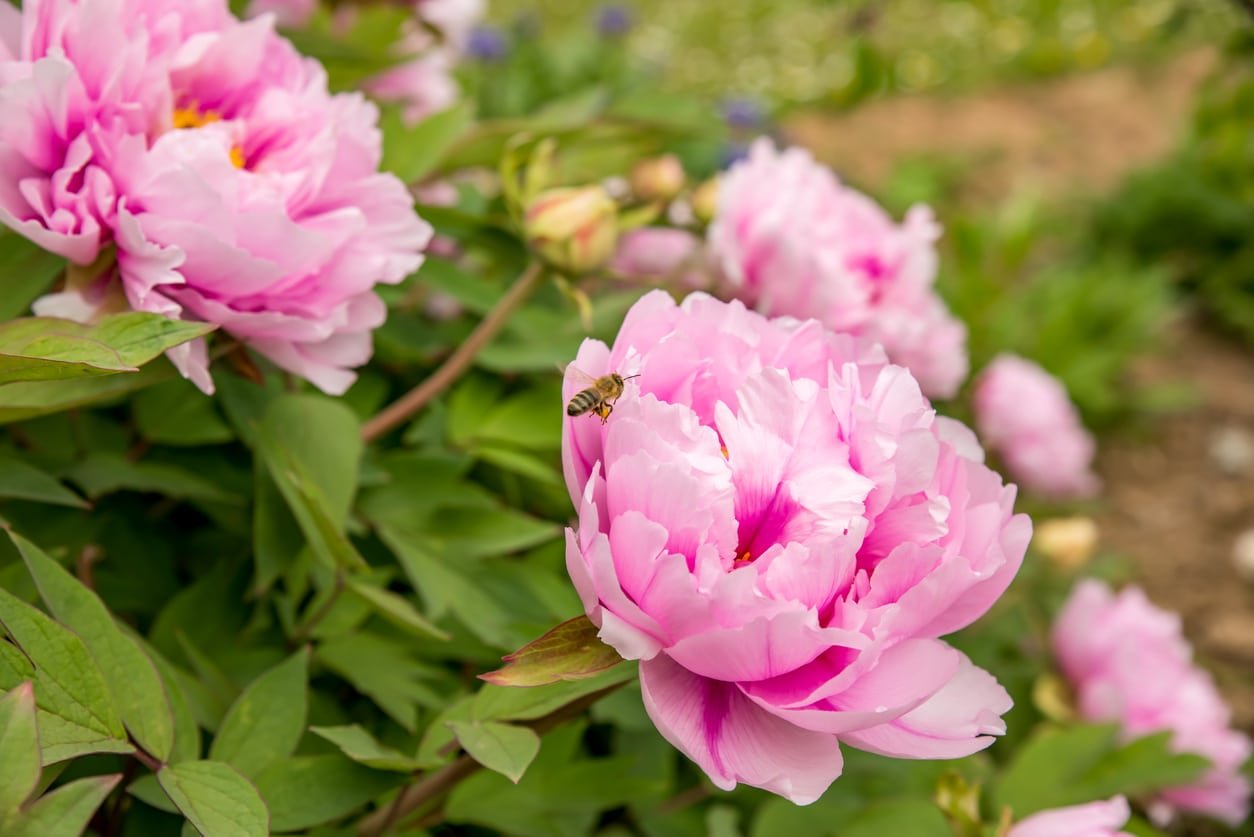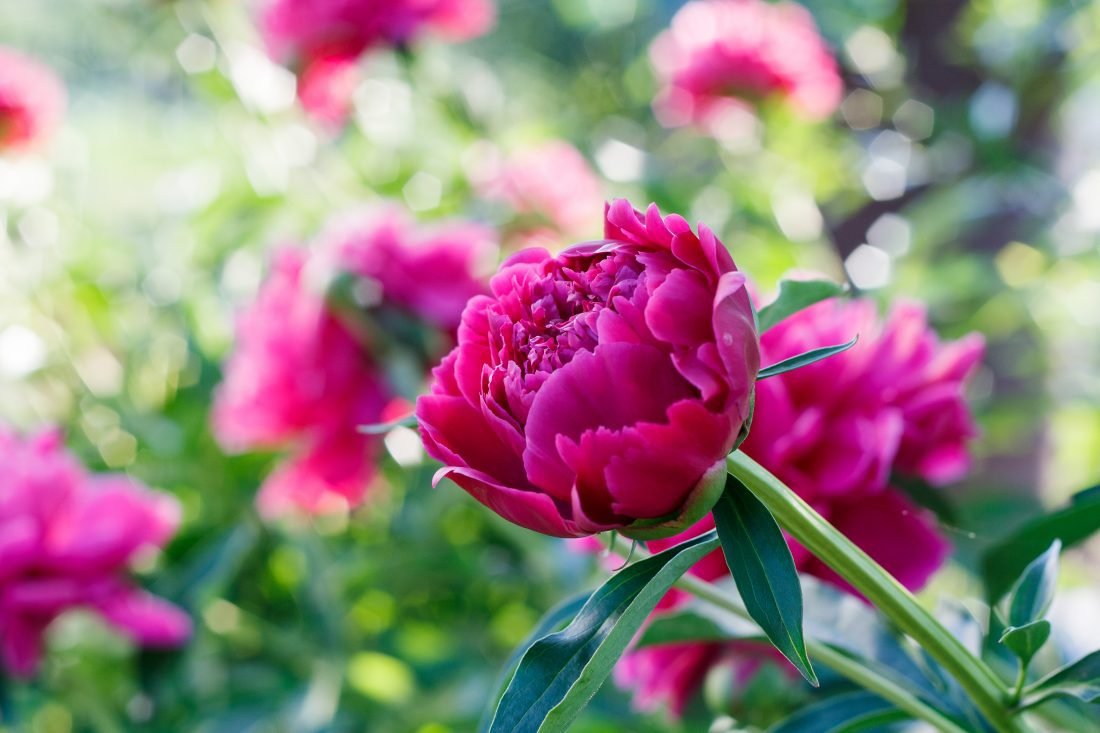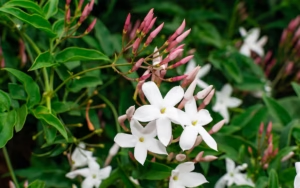Pink peonies are often regarded as one of the most beautiful and fragrant flowers that bloom in gardens. With their lush, voluminous petals and sweet scent, these flowers make an enchanting addition to any landscape. Whether you’re a novice gardener or an experienced horticulturist, understanding the best way to plant, care for, and propagate pink peonies will ensure they thrive in your garden for many years. In this detailed guide, we will walk you through the entire process, from planting and transplanting to dealing with common problems, pests, and diseases.
Information About Pink Peonies
| Common Name | Pink Peony |
|---|---|
| Botanical Name | Paeonia lactiflora |
| Family | Paeoniaceae |
| Plant Type | Herbaceous perennial |
| Mature Size | 2-4 feet tall, 3-4 feet wide |
| Sun Exposure | Full sun to partial shade |
| Soil Type | Well-drained, loamy soil |
| Soil pH | Slightly acidic to neutral (6.0-7.0) |
| Hardiness Zones | 3-8 |
| Native Area | China, Mongolia, and Siberia |
| Toxicity | Non-toxic to humans and pets |
Planting and Transplanting Pink Peonies
Peonies, including pink varieties, thrive when planted in the right environment. These perennials are relatively low-maintenance but need specific care during planting to ensure they flourish. Let’s go over the steps to plant pink peonies, and also how to transplant them if you need to move them to a new location.
Planting Pink Peonies
- Choosing the Right Location
Pink peonies need a location that gets full sunlight for at least six hours a day. While they can tolerate some shade, they will bloom better with more sunlight. The soil should be well-drained and rich in organic matter. Avoid areas with poor drainage, as standing water can cause root rot. - Soil Preparation
Before planting, test the soil’s pH level. Peonies prefer slightly acidic to neutral soil, ideally between 6.0 and 7.0. If the soil is too acidic, you can add lime to raise the pH. Additionally, mix in plenty of compost or organic matter to improve soil texture and fertility. - Digging the Hole
When it comes to planting, dig a hole that’s at least 2 feet wide and deep. The depth of the hole is important because peonies have long, thick roots that need space to grow. If you’re planting bare-root peonies, the buds should be about 1-2 inches below the soil surface. Planting too deep can prevent them from blooming. - Planting the Peony
Place the root ball in the hole, ensuring the eyes or buds face upward. Gently fill the hole with soil and pat it down. Water the plant thoroughly to help settle the soil around the roots.
Transplanting Pink Peonies
Peonies do not like to be disturbed, so transplanting should be done with care and only when necessary. The best time to transplant peonies is either in the fall or early spring while they are dormant.
- Preparing the New Location
Choose a site with similar conditions to the original location: full sun and well-drained, fertile soil. Prepare the new planting hole, following the same procedure as for planting new peonies. - Digging Up the Peony
Carefully dig around the base of the peony, starting several inches from the crown. Avoid cutting into the roots. Lift the plant gently and transplant it to the new location. - Replanting and Watering
Place the peony in the new hole, ensuring that the crown is no more than 1-2 inches below the soil surface. Water the plant generously after planting to settle the soil. Make sure to avoid planting the peony too deep, as this can result in poor blooming.
Pink Peony Care
Peonies are relatively easy to care for once established, but they do require some attention to thrive. Here’s what you need to know to keep your pink peonies happy and healthy.
Watering Pink Peonies
Peonies need regular watering, especially during the first year after planting. Water them deeply once a week to ensure the soil stays moist but not waterlogged. During the blooming season, peonies need more water to support their large flowers. However, be careful not to overwater, as too much moisture can lead to root rot.
Fertilizing Pink Peonies
Peonies do not need excessive fertilization. In fact, too much fertilizer can damage them. Apply a balanced fertilizer once in early spring when the shoots begin to grow. You can also use organic compost to provide nutrients throughout the growing season. Avoid fertilizing once the plant has started to bloom, as it may cause the peony to become leggy and less vigorous.
Mulching
Applying a layer of mulch around the base of your peonies can help retain moisture and prevent weeds. Use organic mulch, such as shredded bark or compost, to cover the soil around the plants. However, make sure the mulch is not piled too high around the crown of the plant, as it can cause rot.
Types of Pink Peonies
Peonies come in many varieties, each offering a different appearance, bloom time, and fragrance. Here are some of the most popular types of pink peonies.
- Single Pink Peonies
These peonies have a simple, open form with fewer petals. They typically have a lighter fragrance and are easier to maintain compared to more complex varieties. - Semi-Double Pink Peonies
Semi-double varieties have more petals than single peonies but still maintain a loose, airy structure. They usually bloom in late spring to early summer. - Double Pink Peonies
Double peonies are the most common and feature fully rounded blooms with many layers of petals. These peonies offer the fullest display of flowers and have a strong fragrance. - Fragrant Pink Peonies
Some varieties of pink peonies are known for their strong, sweet fragrance, such as Sarah Bernhardt. These peonies are perfect for planting near windows or walkways to enjoy their scent.
Pruning Pink Peonies
Pruning is important for maintaining the shape and health of your pink peonies. Here’s how to do it properly:
- Pruning After Blooming
Once your peony blooms have faded, cut the spent flowers off to prevent the plant from wasting energy on seed production. Use clean, sharp pruning shears to remove the flower heads just above the leaves. - Cutting Back in Fall
After the first frost, when the foliage has turned brown, cut the stems back to the ground. Be sure to remove all the dead foliage to reduce the risk of fungal diseases over the winter months. - Maintaining Plant Health
If your peony plant becomes leggy or starts growing in an undesirable shape, cut back some of the stems during the growing season. Always prune above a healthy bud to encourage new growth.
Propagating Pink Peonies
Peonies can be propagated through division, which allows you to create new plants from existing ones. Here’s how to do it:
- When to Propagate
The best time to divide peonies is in the fall, after the plant has finished blooming and the foliage has died back. Alternatively, you can do this in early spring before new growth begins. - How to Divide Peonies
Carefully dig up the peony plant, ensuring you do not damage the roots. Gently separate the root ball into smaller sections, making sure each section has at least one “eye” or bud. Replant the divisions in well-prepared soil, following the same planting guidelines. - Replanting Divided Peonies
When replanting the divisions, make sure to place them at the correct depth (1-2 inches below the soil surface). Water the newly divided plants generously.
How to Grow Pink Peony From Seeds
Growing pink peonies from seeds can be a challenging but rewarding process. Here’s a step-by-step guide on how to grow peonies from seed.
- Seed Collection
After the flowers have faded, collect the seed pods, which will turn brown and dry out by late summer or early fall. Carefully open the seed pods and remove the seeds. - Cold Stratification
Peony seeds require cold stratification to germinate. Place the seeds in a damp paper towel, then store them in the refrigerator for 10-12 weeks. This process mimics winter conditions and helps break the seed’s dormancy. - Planting the Seeds
After stratification, plant the seeds in pots filled with well-draining potting mix. Press them gently into the soil, then cover them lightly with soil. Keep the pots in a warm, sunny location and water regularly. - Transplanting Seedlings
Once the seedlings have sprouted and are large enough to handle, they can be transplanted into your garden. Be patient, as it may take several years for the seedlings to bloom.
Potting and Repotting Pink Peonies
Pink peonies are generally best grown in the ground, but if you’re limited on space, you can grow them in pots. Here’s how to properly pot and repot your peony plants.
- Choosing the Right Pot
When selecting a pot, make sure it’s large enough to accommodate the peony’s root system. The pot should be at least 18 inches in diameter and have drainage holes to prevent waterlogging. - Potting Pink Peonies
Fill the pot with a well-draining potting mix, then plant the peony at the appropriate depth. Water the plant thoroughly and place the pot in a sunny location. - Repotting Pink Peonies
Repot your pink peony every 2-3 years, or when the plant outgrows its container. To repot, carefully remove the peony from its pot and place it in a slightly larger one, following the same planting procedure.
Overwintering Pink Peonies
While pink peonies are hardy and can survive cold winters, they still require some attention to ensure they come back strong in spring. Here’s how to protect your peonies during winter:
- Cutting Back
After the first frost, cut the peony stems down to the ground, removing all dead foliage. - Mulching
Apply a thick layer of mulch (3-4 inches) around the base of the peonies to insulate the roots. This will protect the plant from freezing temperatures and prevent frost heaving. - Covering for Extra Protection
In extremely cold climates, you can cover the peony with a burlap sack or frost cloth to provide additional protection.
Common Problems with Pink Peonies
Pink peonies are relatively pest- and disease-resistant, but they can still encounter a few common problems.
- Poor Blooming
If your peony isn’t blooming, it may be planted too deep, or it may not be getting enough sunlight. Ensure that the soil is well-drained and the peony is receiving the proper amount of light. - Yellowing Leaves
Yellowing leaves can be caused by poor drainage, excessive watering, or a lack of nutrients. Check the soil for drainage issues and ensure the peony is getting enough nutrients.
Common Pests & Plant Diseases
While pink peonies are not highly susceptible to pests and diseases, they can still attract a few unwanted guests:
- Aphids
Aphids are small, green insects that can cluster around the buds and leaves of peonies. They can be controlled with insecticidal soap or by spraying the plant with a strong jet of water. - Botrytis Blight
This fungal disease can cause gray mold to form on the flowers, leading to premature wilting. To prevent botrytis blight, make sure the peony is planted in a well-ventilated location with good air circulation.
How to Get Pink Peonies to Bloom
If your pink peonies aren’t blooming as expected, there are several things you can do to encourage them to flower:
- Proper Planting Depth
Ensure the peony’s eyes are planted 1-2 inches below the soil surface. Planting too deeply can prevent blooming. - Sunlight and Soil
Peonies need plenty of sunlight to bloom. Make sure they are planted in a spot that receives at least six hours of sunlight each day. - Proper Pruning
Avoid cutting back the peony too much. Deadheading spent flowers after they bloom will help redirect energy into the plant’s roots for future blooms.
FAQ
1. When should I plant pink peonies?
Plant pink peonies in early fall or early spring while they are dormant. Fall planting gives them time to establish their roots before winter.
2. How long do pink peonies live?
With proper care, pink peonies can live for decades, with some plants reaching 50 years or more.
3. Can I grow pink peonies in a container?
Yes, but they need a large enough container and well-draining soil to thrive.
4. Why aren’t my pink peonies blooming?
Possible reasons include being planted too deeply, lack of sunlight, or poor soil drainage.
Read also: How to Grow and Care for Peonies: A Comprehensive Guide










